|
|
|
Sort Order |
|
|
|
Items / Page
|
|
|
|
|
|
|
| Srl | Item |
| 1 |
ID:
174776


|
|
|
|
|
| Summary/Abstract |
China’s naval footprint in the Indian Ocean has expanded considerably over the last decade. This growing presence has led to significant debates about China’s goals and capabilities in the region. This article argues that China’s trajectory over the last ten years reflects an alignment of ends, ways and means in the Indian Ocean. The main driver behind China’s ambitions in the region is the need for Beijing to secure pivotal maritime lines of communications that carry a large share of Chinese oil imports and a sizable part of Chinese exports. Fulfilling this mission has required a significant adjustment of China’s naval strategy, and the addition of ‘open seas protection’ to the core missions of the PLA Navy. This strategy has, in turn, been supported by the development of a navy with increased sea control capabilities and overseas basing plans that have started to materialize in Djibouti.
|
|
|
|
|
|
|
|
|
|
|
|
|
|
|
|
| 2 |
ID:
174774
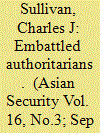

|
|
|
|
|
| Summary/Abstract |
Why are some authoritarian leaders able to stave off violent challengers to their rule while others falter? This article analyzes several case studies involving a series of nondemocratic governments and violent non-state actors waging war and posits that different combinations of variables lead to dissimilar outcomes (ranging from “civil war/insurgency”, “regime implosion” or “foreign-based overthrow”, “negotiated peace”, to “strategic advance and retreat”). Accordingly, “embattled authoritarians” require a high level of “political-military aid” over time from a supportive foreign power to effectively combat “violent non-state challengers”. However, it is difficult for such governments to completely escape from “embattled” status, particularly if a supportive foreign power does not exert influence to set parameters for peace between the warring parties and the level of international interference (i.e. political-military aid abetting violent non-state challengers courtesy of other foreign powers) does not recede over time. This article concludes with a forecast on Afghanistan and Tajikistan’s respective futures and discusses how the onset of political instability within the former may serve to destabilize the political situation in the latter.
|
|
|
|
|
|
|
|
|
|
|
|
|
|
|
|
| 3 |
ID:
174775
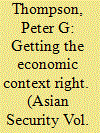

|
|
|
|
|
| Summary/Abstract |
World War I has become the “go-to” analogy for understanding the contemporary security dynamic in East Asia, especially as it concerns US-China relations and the possibility of war. However, this analogy fails to account for the fundamental changes in economic flows in the current environment, specifically the growth and proliferation of foreign direct investment (FDI). Capital flows were primarily portfolio investments in 1914, while FDI flowed from great powers to secondary, allied states. This is not representative of East Asia today, where FDI flows between possible belligerents in any future conflict and global value chains link states within and across regions. Ultimately, World War I may no longer provide a satisfactory analogy for understanding the impact economic interdependence has on modern war given FDI’s importance in the global economic system.
|
|
|
|
|
|
|
|
|
|
|
|
|
|
|
|
| 4 |
ID:
174770
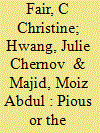

|
|
|
|
|
| Summary/Abstract |
Indonesia is generally viewed as a moderate Muslim nation that episodically struggles with terrorism. Between 1981 and the end of 2016, Indonesia experienced 156 attacks from some 15 Islamist militant groups. However, the lineaments of popular support for Islamist militancy in Indonesia remain understudied. In this paper, we expand upon the existing literature on popular support for Islamist violence in Indonesia by replicating and extending the empirical framework for modeling the relationship between support for various conceptualizations of Shari’a and support for Islamist violence offered by Fair, Littman and Nugent (2018) for Pakistan and extended to Bangladesh by Fair, Hamza and Heller (2017). To do so, we conduct ordered logistical regression analysis of Pew survey data which includes information about respondents’ religious beliefs and practice as well as support for Islamist violence. We find considerable evidence that their framework is useful for understanding support for violence in Indonesia.
|
|
|
|
|
|
|
|
|
|
|
|
|
|
|
|
| 5 |
ID:
174772
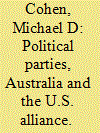

|
|
|
|
|
| Summary/Abstract |
What causes variation in the foreign policies of U.S. allies regarding their desired U.S. military role in their region and their troop commitments to U.S. military interventions? This paper addresses this question through documenting and explaining the sources of variation in Australia’s foreign policies regarding these issues over four decades. Treating the two major political parties in Australia and their respective leaders who self-select into them as endogenous, the paper argues that Australian foreign policy, whilst always supportive of the U.S. alliance, has systematically varied. This variation has correlated with the political party in power while the late Cold War and post-Cold War balances of power remained constant. While the Labor party has only been willing to send combat troops to large U.S. military interventions when the latter have a supporting United Nations Security Council Resolution, the conservative Liberal party has been willing to military intervene without this multilateral support. The Labor party, unlike the Liberal party, has also frequently proposed the formation and consolidation of multilateral regional institutions. These preferences render the U.S. to have been necessary for the Labor Party but sufficient for the Liberal party. Future Sino-U.S. armed conflict would provide a harder test of these hypotheses.
|
|
|
|
|
|
|
|
|
|
|
|
|
|
|
|
| 6 |
ID:
174773
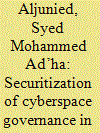

|
|
|
|
|
| Summary/Abstract |
Drawing from securitization theory and Critical Discourse Analysis (CDA), this article examines how the Singaporean government has “securitized” cyberspace governance. It contributes value-add to the existing literature on securitization theory by evaluating the specific backgrounds and preexisting beliefs that securitizing actors bring with them to the securitization process. Taking the case of Singapore, this paper focuses on the military elites turned civilian politicans and policymakers that have been tasked with cyberspace governance. A discourse analysis shows how terminologies describing cyberspace as an “existential” issue and key personnel appointments with significant military backgrounds reflect the prevalance of military elites, terminologies, strategies that have become embedded within domestic cybersecurity governance structures. The use of military-style concepts such as “digital ranges” and “war games” in Singapore mirrors global financial industry trends where military-derived terminology has become widespread in preparing for cyber-attacks on critical information infrastructure. Two key focus areas of cyberspace governance are evaluated: online content regulation of Internet and social media networks, and legislation to protect critical information infrastructure. The paper concludes by discussing a range of concerns raised by the target “audience” of securitization processes, such as civil society and information infrastructure providers.
|
|
|
|
|
|
|
|
|
|
|
|
|
|
|
|
| 7 |
ID:
174771


|
|
|
|
|
| Summary/Abstract |
Scholars have argued that governments rely on pro-government militias forces due to low state capacity or international pressure that limits how they use military force within the context of civil wars. This article argues that governments also strategically use militias both inside and outside of civil wars to support the political legitimacy of local systems of governance in developing states, especially in peripheral areas with limited government control. This suggests that long-term political motivations need to be considered alongside short-term tactical goals for a comprehensive understanding of militia support. This theory is supported by case studies of Pashtun tribal militias in British India and Pakistan based on archival research, interviews, and relevant secondary sources.
|
|
|
|
|
|
|
|
|
|
|
|
|
|
|
|
|
|
|
|
|